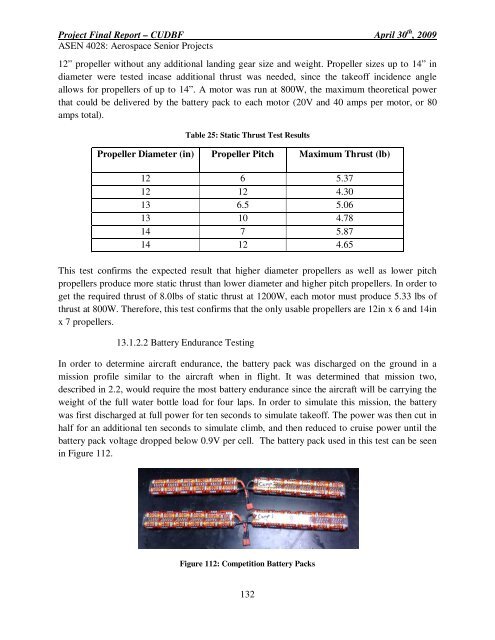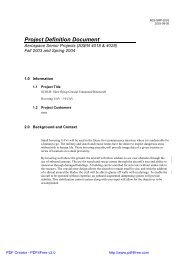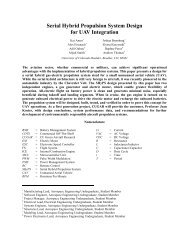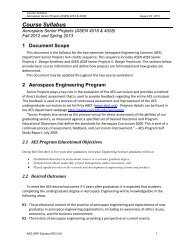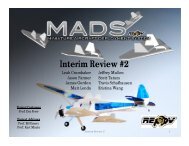PFR - Aerospace Engineering Sciences Senior Design Projects ...
PFR - Aerospace Engineering Sciences Senior Design Projects ...
PFR - Aerospace Engineering Sciences Senior Design Projects ...
Create successful ePaper yourself
Turn your PDF publications into a flip-book with our unique Google optimized e-Paper software.
Project Final Report – CUDBF April 30 th , 2009<br />
ASEN 4028: <strong>Aerospace</strong> <strong>Senior</strong> <strong>Projects</strong><br />
12” propeller without any additional landing gear size and weight. Propeller sizes up to 14” in<br />
diameter were tested incase additional thrust was needed, since the takeoff incidence angle<br />
allows for propellers of up to 14”. A motor was run at 800W, the maximum theoretical power<br />
that could be delivered by the battery pack to each motor (20V and 40 amps per motor, or 80<br />
amps total).<br />
Table 25: Static Thrust Test Results<br />
Propeller Diameter (in) Propeller Pitch Maximum Thrust (lb)<br />
12 6 5.37<br />
12 12 4.30<br />
13 6.5 5.06<br />
13 10 4.78<br />
14 7 5.87<br />
14 12 4.65<br />
This test confirms the expected result that higher diameter propellers as well as lower pitch<br />
propellers produce more static thrust than lower diameter and higher pitch propellers. In order to<br />
get the required thrust of 8.0lbs of static thrust at 1200W, each motor must produce 5.33 lbs of<br />
thrust at 800W. Therefore, this test confirms that the only usable propellers are 12in x 6 and 14in<br />
x 7 propellers.<br />
13.1.2.2 Battery Endurance Testing<br />
In order to determine aircraft endurance, the battery pack was discharged on the ground in a<br />
mission profile similar to the aircraft when in flight. It was determined that mission two,<br />
described in 2.2, would require the most battery endurance since the aircraft will be carrying the<br />
weight of the full water bottle load for four laps. In order to simulate this mission, the battery<br />
was first discharged at full power for ten seconds to simulate takeoff. The power was then cut in<br />
half for an additional ten seconds to simulate climb, and then reduced to cruise power until the<br />
battery pack voltage dropped below 0.9V per cell. The battery pack used in this test can be seen<br />
in Figure 112.<br />
Figure 112: Competition Battery Packs<br />
132


